1980/2010 Giovanni Imbalzano Lulu © La magica storia della Santa Sindone
Dall'inizio dei secoli
Certificato dai Tre Re, Santa Nouné, Taddeo e Tommaso, Pietro e
Luca, Matteo e Giovanni, Giuseppe d'Arimatea e Maria di Betania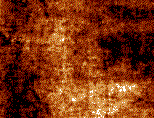
![]()
«Un giovanetto però lo seguiva, rivestito soltanto di un lenzuolo, e lo fermarono. Ma egli, lasciato il lenzuolo, fuggì via nudo» Marco (14, 51-52)
From the first of centuries!
Comneni Dynasty 1192 Pray Codex
1° MILLENIUM: Constantine VII, Omar I, Baradeus, Bar Daisan, Mar Aggai, Abgar V..!
Constantine VII 944 Coins
Of course, the Holy Shroud was seen by the Crusaders in Constantinople in 1203 (as said Baron Robert de Clairy) and much earlier in 1151 by the Benedictine Icelandic N. Saemundarson and in 1058 by a Christian Arab, the scholar Abu Nasr Yahya, from Isaac I Comneno, and the son Alexius I have offered to Christian principles, as a pledge for the war against the Turks, "linteamina post eius resurrectionem invents sepulcro" (1081-1118).
On these was the image of Christ, as John the "Geometer" (meantime priest of the Imperial Palace) reminds us of. Please note that in 1201 Nicholas Mesaria, a simple guard, has described just sheets of fine linen, some willing to deceive the primitive Crusaders, so that they have led to Besançon a false shroud!
Dopo il fatidico anno 944, di cui più sotto, si scrive di nuovo al riguardo della leggenda di Abgar
1212: Otia imperialia di Gervasio Tilbury
1140: Historia Ecclesiastica di Orderico Vitalis
1100: Giorgio Cedreno
scrive della processione dell'anno 1036 con cui si pregava per la fine della siccità e, per primo, chiama il sudario come “Mandilion”.Gli scrittori passano dalla descrizione dell'immagine di un volto, per così dire nella versione originale della leggenda, all’esistenza dell'impronta dell’intero corpo.
Nel Codice di cronaca bizantina del secolo XI, conservato nella Biblioteca nazionale di Spagna a Madrid, è mostrato l’arrivo a Costantinopoli (nel 944) del “Mandilion” con l’intera immagine del corpo.
![]() 16 August 944: Byzantium acquires the Shroud from the Arab chiefs; in 641 the 2.nd Caliph Omar had conquered the Edessa city, but he respected our cult.
16 August 944: Byzantium acquires the Shroud from the Arab chiefs; in 641 the 2.nd Caliph Omar had conquered the Edessa city, but he respected our cult.
Mark of the "owner"...
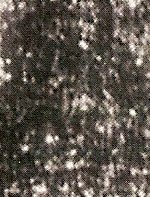 on the right of the frontal lobe, like in this coin?
on the right of the frontal lobe, like in this coin? 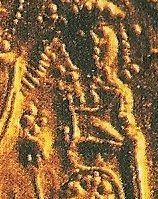 Byzantium 1067 / 1071.
Byzantium 1067 / 1071.
For the hypothetical coins over the eyelids of the Man of the Holy Shroud or that have minted to the purpose
Constantine VII, you can read
" Leonardo & Company". "Render to Caesar the things that are Caesar's, and to God the things that are God's." (Mark 12,17)
ANATHEMAS IN CONNECTION TO SACRED IMAGES
I) If someone does not admit that Christ our God can be limited, according to the humanity, is declared an anathema.
II) If someone refuses that the Gospel histories can be represented with designs, is declared an anathema.
III) If someone does not greet these (images, made) in the name of the Lord and its Saints, is declared an anathema.
IV) If someone rejects every ecclesiastical tradition, that written as that not written, is declared an anathema.
II Nicea Council (787) Pope Adriano I.
In questo periodo, Giorgio il Monaco ricordava la leggenda di Abgar di Edessa, dove si conservava l’immagine di Cristo, ciò che fu ricordato anche durante il Concilio. Lo stesso fecero i Patriarchi d’Oriente Cristoforo di Alessandria, Giacobbe di Antiochia e Basilio di Gerusalemme, con una lettera sinodale indirizzata all’imperatore iconoclasta Teofilo, nell’836 e Teofane descriveva l’Acheropita (758-818). Evidentemente, la Sindone non si trovava a Costantinopoli e non poteva correre alcun rischio per un eventuale intervento dell’imperatore. Essa non si trovava neppure a Gerusalemme, da cui tutte le reliquie erano state salvate nel 614 dall’invasione dei Persiani, ma in mano degli Arabi a Edessa, donde la Sindone fu recuperata nel 944.
749: Giovanni Damasceno (†749)
menziona la Sindone nel suo lavoro anti-iconoclastico sulle sante immagini, e cita la leggenda di Abgar, che aveva richiesto un'immagine di Gesù, il quale avrebbe adagiato una stoffa sul volto per produrre la propria immagine.La stoffa è descritta quale striscia oblunga, piuttosto che un fazzoletto, come potrebbe ritenersi.
Sacred Koran, Sura LXXXVIII (Al-Ghƒshiya):
"1) You it is reached news of the Wrapping? 2) There will be, in that Day, ashamed Faces, 8) There will be, in that Day, happy Faces,
23) As for who he turns the shoulders and does not believe, 24) Allah will punish it with the greater punishment." Abu Bekr (1.st Caliph 632-634
AC)
Iconoclast allowing, the Shroud was exhibited, folded, at least among 775 and 802
AC in concomitance with the definition of the Nicea II Council
.
Great THANKS for the Muslim friends, that they have conserved and saved our Holy Shroud!
Christ raze wild animals, sculpture of Byzantine influence,
VII / VIII century:
 Cross of
Bewcastle
(London, Victoria and Albert Museum).
Cross of
Bewcastle
(London, Victoria and Albert Museum).
Life of S. David (589-601~): Glastonbury was the first of twelve monasteries (e. g. Bewcastle) to be founded "...according to certain of the ancients, S. Joseph (perhaps Joseph of Arimatea, deriving by the Diaspora of Jerusalem) lies buried with a great multitude of saints." (Rhygyfarch, 1090). Glastonbury is boasted to conserve the spoils of its first Bishop, the Saint Patrizio of the Alfalfa of Ireland (433-472) and Arthur († 537) the fabled King of the Templars.
I cristiani approdarono effettivamente in Inghilterra nel II secolo, importandovi la lavorazione aramaica di tessuti come la Sindone, come si è scoperto in una sepoltura del 60 dC a Colchester. Dopo l’Arcidiocesi di Londra istituita da Papa S. Eleutero (†189) nel 596 fu completata l’evangelizzazione dell’Inghilterra, con l’arrivo a Canterbury del monaco Agostino (†607) inviato da Gregorio Magno (il censore degli iconoclasti) che consegnò ad Agostino una delle icone di Cristo, prodotte in Camulia di Cesarea (Cappadocia
). È del tutto plausibile che questa stessa icona abbia ispirato lo scultore della Croce di Bewcastle.Una di queste icone, fu donata nel 797 a Carlo Magno e conosciuta dall'877 quale "Sindone di Compiègne", ma fu poi distrutta dalla Rivoluzione francese. Lo storico Beda (672-735) nella sua Storia della Chiesa d'Inghilterra cita la testimonianza di Arculfo, che nel 670 aveva visto una certa Sindone (certamente priva della vera immagine) a Gerusalemme. Arculfo ne ricorda le misure, con un'esagerazione del 15% rispetto alla metà frontale della Sindone che conosciamo oggi; il gesuita J. Francez (1935) sostiene che fu questa la copia donata a Carlo Magno. Dalla scuola artistica di Carlo Magno proviene un dittico d'avorio (conservato al Museo Nazionale di Firenze) che rappresenta la tomba del Risorto, con un evidente tratteggio "a spina di pesce" come nella tessitura della Sindone di Torino.
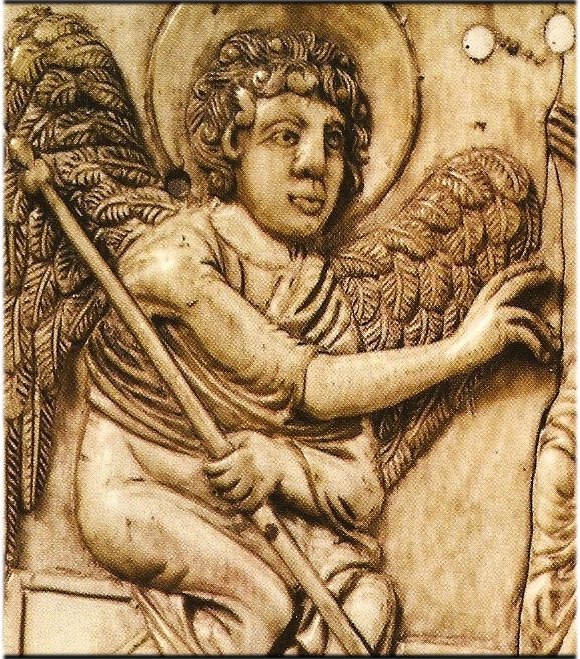
In the
Dynamic preview of the Holy Shroud Man
we will observe the Sudarium with the blood, released under the neck but still
retreated in back of the nape.
In the first copies of the Holy Shroud, fore to the fire of the 1532, is well
visible, together with the L sign, a slimed crown of spines.
(G. Cingoli, L. Coppini, M. Fanti, Fig. 3, II Convegno Sindonologia, Bologna 1981)
The medical-anatomical perfection seems unbelievable, also to comparison with the Pietas of Michelangelo. Stains of the Oviedo Soudarion are in agreement with Holy Shroud in many details invisible naked eye, besides the flax, interweave like Z, and blood masculine group AB. But on Holy Shroud we find also pollens Turkish - Palestinians and Italy - French kids, impressions of Middle East flowers, particularly Israel, some trace of human epidermis in areas of blood and rare crystals of aragonite, which are typical of the caves of Jerusalem. Before the invasion of the Persians of 614 AC the Sudarium was certainly in Jerusalem: also why the dating of C14, exceeding 680, is resoundingly errata as confirmed more forward. We catch a glimpse on it some fingers, who tried of halting flow nosebleed, with cloth wrapped on head of this victim without dirtying of blood of a dead man under Law Judaic. The disinfection was continued in sepulcher with aloe, myrrh and least another bandage rubbed above the face as described the paragraph:
Leonardo & Company.
![]() In the
Dynamic preview,
In the
Dynamic preview,
with studying the the back we see a double knot, adapted to hold the Soudarion during transport:
the node seems slipped and then keeped by the central lock of long hair, during the deposition in the tomb.
The Emmanuel and Nazarene (Matthew 1,22 e 2,23;
26,12) or the Uncut of Nazareth :
"In pouring this
ointment on my body, she has done it to prepare me for burial."
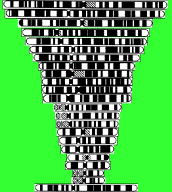
The DNA Cup, a realization of the author
Joseph of Arimatea: "There there was the Holy Shroud
and the Soudarion for its face" (Apocryphal Gospel of Nicodemus XV, 6) IV
century.
Acts (5,6) reminds us that the use of a sheet for bury was normal in that time, but Joseph, a rich man, he used his own tomb, built just near to Golgotha.
The use of a flax for enfold the body of a dead it's recorded from ancient relics of the Antipolis Cemeteries in Egypt (II century) and Jerusalem (I century). From the excavations of Antipolis at east of the Nile, in 1902 many laces appeared, and at least two pillows herringbone of an artistic setting similar to production of the Sassanid Persia and also four shuttles for the weaving, as well as a tunic (dated 340), a great shroud (455) and a shroud with the imprint of a face, now lost. Under the hips and the neck of the Shroud Man, we see some hands disposed in manner that gently lower the body. On the legs and over his head, other bandages used for moving the body and the crown of thorns (for this, may see more ahead). All this suggests presence of at least two pitiable persons.
John: "...they has stretched a new Sudarium on Him, they have overwhelmed Him with many spices and abundant myrrh... they have Him ready to the tomb,
as it is be necessary, with aromas and incense smoke and with new bandages of flax" (Apocryphal Gospel of Gamaliele IV century, Ethiopia)
Segue un brindisi del poeta e storico Giorgio Pisides, con una descrizione della Sindone, qui descritta come acheropita, per la sconfitta dei Persiani da parte dell’Imperatore Eraclio I a Ninive, oltre Edessa (628 dC). Prima di Pisides, anche lo storico Teofilatto Simocatta nomina l'immagine "acheropita" che fu di buon auspicio per la guerra contro i Persiani Sasanidi.
"Prese la figura divina e venerabile, l'immagine della scrittura non scritta, che non fu delineata da mani umane, ma che fu fatta dal logos secondo la sua arte
/
generato senza seme dell'uomo/ dal logos che forma l'universo... Fidandoti di questo archetipo / che
Dio ha delineato, hai messo in atto / l'opera delle battaglie."
"He took the divine and venerable figure, the image that never was writed, never delineated by human hands, but made by the Logos in accordance to its art /
this was generated without seed of man / from Logos that
shape the universe... you trusting of this archetype / that God has outlined,
you have implemented / the masterpiece of battles."
Eraclius 628 Sudarium
Baradeus 544 Tetradiplon
In 570, a devotee of St. Anthony, from Piacenza in pilgrimage to Jerusalem, without mentioning any image, proclaims that he have seen the Sudarium,
"which was on the forehead of the Lord" kept secretly in the cave of a monastery over the Jordan river. It was not certain the Shroud, but the
Sudarium of Oviedo, locked in his small ark and placed in a certain catacomb, at time of the Diaspora of Jerusalem in the 70 AD.
Some indication comes from the previous narrative, when writes that he saw a marble obelisk surrounded by railings and a wooden cross stuck in the water,
with a scale on the sides of the obelisk: "There is an obelisk surrounded by gates and at the point where the water flows back in its bed a wooden cross is placed
on a pedestal, in the water all about the marble." The pilgrim came to the river on the feast of the Epiphany and he witnessed the blessing of the water from a priest,
and many believers which was there for bathe himself in the river "All people and they plunge into the river for the blessing wearing the shroud and many other objects
that they conserve for their burial". The site that he mention, especially in comparison with other writers, is certainly the first Sanctuary of Bethany, thereabout where was John for the baptism of Jesus. Before finding the Sudarium, he went forward along the banks of the Jordan, unto "the source, where John was baptizing, just two miles from the Jordan" and around to the valley there was a multitude of hermits, and nearby there is the city which is called Livias. The place is today's Wadi Kharrar Shrine, which commemorates the cave of John the Baptist, and there nearby the pilgrim saw the Sudarium, with no one picture, maybe at Ain Karem, the refuge of Elizabeth.
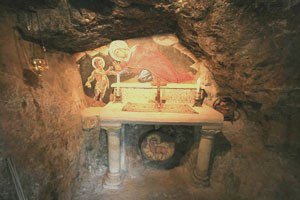
In Jerusalem it was honored the Temple of Jupiter (Adriano, 133) until the inauguration of the Church of the Sepulchre (St. Helena, 370) and here,
in the year 383, a Spanish man (a certain Egeria) saw the "Title of the Cross" but not the Shroud. A long time was necessary,
before showing the Sudarium covered with blood, because at start it would offend the culture of the Jews Christians, as I mentioned,
but some "false" shrouds there were; occasionally they was used as vestments, or for Baptism of adults.
"After that He abandoned the footprints Joseph (of Arimatea) to
the grave, He take back from the grave those of the Man that had produced Joseph"
(Carmen 41, 13.20
of Romano Melode †555)
The "Letter of Jesus to Abgar V" describing its body on the Sacred
Sheet:
"Si vero corporaliter faciem meam cernere desideras, heu tibi dirigo linteum, in quo non solum faciei mee figuram, sed tocius corporis mei cernere poteris statum divinitus transformatum"; supra quoddam linteum ad instar nivis candidatum toto se corpore stravit, in quo, quod est dictu et auditu mirabile, ita divinitus transformata est illus dominice faciei figura gloriosa et tocius corporis nobilissimus status, ut qui corpolariter in carne dominum venientem minime viderunt, satis eis ad videndum suficiat transfiguratio facta in linteo: on the Mandilion" the whole image of the Christ bright body appear, and He is described as "vanishing" and with a wound to the cost.
Codex Parisiensis BB Lat 6041, Universit di Leyda (NL) & Vossianus Latinus Q 69 & (X century) what cite Aramaic texts of the VI century, recovered to Jerusalem from the medic Smera.
Under the Patriarch Asclepius, who was designated in Opposition to Monophysites, in 525 Edessa city was destroyed by a flood (as in 201)
but the Shroud was safe; meantime Asclepius died in Antioch in 526.
![]() The
Orthodox point out that, after a warning dream, the Bishop of Edessa in 544
Baradeus, a fierce but ambiguous Monophysite, have finded, out of town,
The
Orthodox point out that, after a warning dream, the Bishop of Edessa in 544
Baradeus, a fierce but ambiguous Monophysite, have finded, out of town,
the "Keramidion" or rather he construct the finding of it. Aforementioned "Mandilion", this object is recognized in Sofia (Bulgaria) as the Shroud
(tucked for four times, the socalled Tetradiplon) with evidence of the Visage.
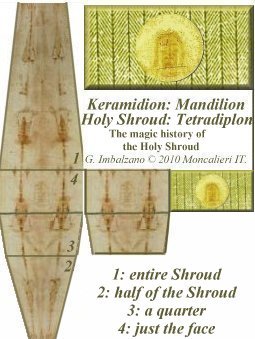
So the Bishop discover that the lamp (still luminous) have imprinted the image on the protective CLOTH or TELA
(unfortunately confused with the English "tile", for "TEgoLA").
The Orthodox Georgian Church remembers that was their Bishop Eulavio that have "dreamed" the Shroud while Cosroe has besieged Edessa;
the Georgians were faithful to the Councils, by the 325 and the 451, as the Bishop Ethalah of Edessa; how I specify in the paragraph to him dedicated,
had hid by them that Shroud... what then the Bishop have "found" in a Shelter far from Edessa.
. ‡ . † . ‡ .
Unanimously with when over, in Orient the Saints have know that the Holy Shroud were hiding in the region of Mtskheta
(not away from Agaçalti of Armenia) while the "True Cross" were buried in Jerusalem.
Without entering into the disputes between the Greek language of John and Aramaic of Matthew, more adherent to the Jewish culture of the time,
we must accept that this nothing other was than the Shroud itself that was bought by the Byzantines in 944.
Immediately afterwards the Shroud was in "ostentation" against the assaults of the Persians, defeated with the use of hot bitumen...
and so the Shroud shows some signs of pitch! The reference for the Feast of the Lights or "Chanukah" of Jews is at all obvious:
it commemorates the new dedication of the Temple of Jerusalem immediately after the victory of Judah Maccabee against the Syrians in 165 BC,
where the votive lamp oil is served for eight days instead of one. So also Jewish books remember , as Magillat Antiochus,
around the first century after Christ, and the Septuagint, codified by Catholics and Orthodox of Eastern Europe.
With the fire, at the Mount of Moses... "Jeremiah went and founded a compartment in shape of a cave and there he introduced the tent, the ark and the
altar of incense and he blocked the entrance... on saying: 'The place must remain unknown until the case that God will not have met all his people
and He same will be shown himself auspicious'." (4.36-49 1 Maccabees, 2 Maccabees, 1.18-2.7)
After some disasters (201, 525) the Shroud is appeared again: from the year 525, nearly two decades will pass before the "discovery" of the Bishop Baradeus.
Of course, he knew where one could find the Towel, away from Edessa, however he not declared her transfer,
by now prohibited by the Code of Theodosius II of the year 435.
poetic verses of Bar-Daisan (Christian Gnostic, 155-233 AC) "Son of the river Daisan"; in 202-214 he have converted the King of Edessa Abgar IX.
Edessa was flooded in 201 as in other times, and was not
certainly not the place where one could conserve the Shroud.
From the "Travels of Egeria in Edessa" (385 AC) J. Markwardt deduce that Abgar IX have married Shalmath (~ 212 AC) while PALUT his Patriarch
not have officiated in Edessa but at Antioch, in the presence of the sacred cloth, the indestructible talisman. The same Patriarch had been consecrated in 191
from Serapion, just to Antioch where he led the Shroud from
Edessa, for remove it from the King Ma'nu, the murderer of Aggai (~ 190 AC).
Note that PALUT was chosen in preference to Mar-Mari, less Christo-centric, to
fight Gnostic propaganda of his friend Bar-Daisan and for correcting the
Christians of Edessa.
But Caracalla 216 conquered the city: the Romans colonized the reign of Abgar
and they built trenches in Palmyra (ancient center for the production of flax,
Christianized from 135) against Persians. From the year 240 (with Sassanid) this
warriors began with persecutions of the Christians, also against Rome and
Byzantium: Shabur (I) conquered Edessa in the year 259, after the attack in 252
of Antioch, who the successor (Chosroes) was able to loot in 540.
Nevertheless, from the year 252 to the 380 the patriarchy of Antioch holded as
many as twelve informal Councils, and this would explain who the features of the
shroud was known to Roman artists of the time. But in the ancient catacombs,
near the Lake Van, there is best recall of the Shroud, most of the IV century:
exactly in the century of the discussion of images, the Shroud was in more safe
places, well out of Antioch and out Edessa, long before the Schisms (Assyrian or
Nestorian of the 431 and Miafisita or Monophysite of the 451).
Per quanto segue, è bene osservare che questi ultimi sono piu' vicini alla concezione trinitaria
di Palut, e gli altri a quella opposta di Mar Mari.
~ ~ ~
In absence of writed documents of the V century... the C14 analyses show the authenticity of the Holy Shroud: ~ ~ ~
"...whether the Shroud samples were irradiated by neutrons (which certainly could make a date appear younger than the true date).
This idea is difficult to disprove..." (R. E. M. Hedges, Oxford Laboratory for Archaeology)
In fact, among the century IV and V, the Shroud were present own in volcanic zones, they preserving at best the
neutron radiations, exactly as if to the ETHALAH time. All this is surely contained in the
Before the fourth century, in addition to the aforementioned "Hymn of the pearl" of Bar-Daisan († 222) in second and third century
we can still deduce the implicit references to the Shroud, or rather to its shape disfigured by the passion and not only according to step (53.2) of Isaiah, but at least
from Justin († 167) Celso (180) Clement of Alexandria († 215) Tertullian († 222) Origen († 253) for which I refer to the work of S. Zardoni, cited in Bibliography.
For example Origen, a pilgrim from Egypt to Italy and from Palestine to Cappadocia (for which he knew surely that the average height of the Arameans
of Israel was less than others) writes "Jesus, even if was deformed but not miserable, was not small" contrary to what stated by the pagan Celsus. Besides that,
he construct (by his cause of fact!) an exegesis of Isaiah (53, 1-3) insisting on the word "bush" which means only a shrub with many branches, not necessarily high:
i
n fact, according to calculations of the 1976, the picture on the Shroud appears as a man of 179 cm and 79 kg!References to the Shroud seems more explicit in the Apocrypha, writings from the year 100,
of which I have selected here passes what can be interpreted in keeping with the history, the science and the Gospels.
L'Epistula Apostulorum (170 dC) insiste sulla "corporeità" di Cristo risorto, ricordando che Egli
mostrò le sue impronte lasciate sulla sabbia a Giacomo e si fece toccare da Pietro,
in contrapposizione
all'idealizzazione gnostica della persona di Gesù. Quest'ultima teoria influenzò forse le prime copie delle
Scritture: il brano di Luca (22, 43-44) citato nella Premessa sulla
Congettura quantistica per l'immagine
sindonica era assente in alcune versioni (Siriaca, Egiziana e vetero Vaticana) nonostante che il brano di
Giovanni (21, 4-14) metta in evidenza un sicuro rapporto del Risorto con la materia.
Ma il brano fu mantenuto dai più antichi Codici (di Beza, Sinai, Antiochia, vetero Latino e Vulgata) fin dal II secolo.
Se fosse necessario, ciò conferma che la Sindone venne nascosta da chi rifiutava di accettare pienamente anche la natura
umana di Gesù Cristo, almeno fino al V secolo. S Girolamo: "Cerchiamo di imparare sulla terra quelle verità la cui
consistenza persisterà anche nel cielo"
(Epistola 53, 10, citazione di Benedetto XVI, Udienza generale 14/11/2007).
Abgar IX 214 Monasteries
Abgar V 46 AC Mandilion
Given the close connections between the Shroud and the Sudarium of Oviedo, from the same crucifix and that
the pollen similar was found only in Jerusalem, just there had to be both during the deposition and burial.
This
was definitely before 214 and the 46 AC: the dates are deducted from the legends
of Abgar, King of the Edessa dynasty.
Remember that the "legend" is the more old mean to tell the story, but we should be able to open it.
To the fourth century, the bones of St. Thomas were translated to Edessa. Thomas, martyred in India approximately in the 72 AD,
already was known to the faithful Syrians, and legends says that in the first century Thomas had sent to Abgar (V) Jude Thaddeus.
But it would be more correct to say that together they began their mission to the East,
there "they sent" and "they were accompanied" from (image of) Risen Lord, training new disciples
(Doctrine of Addaj, ecclesiastical history of Eusebius, Acts of Judas Thomas). The three evangelists of Syria,
Thaddaeus, Simon and Thomas were translated from Edessa in Italy during the the Crusades (I and IV) following the fortunes of the Holy Shroud.
Judas (not Iscariot) said to him: "Lord, how is it that you will manifest yourself to us, and not to the world?" Jesus answered him:
"If anyone loves me, he will keep my word, and my Father will love him, and we will come to him and make our home with him."
{John 14,22-23} See: The Spoils of Judas Thaddaeus.
~ ~
Narratio de Immagine Edessena (944-959) of Constantinus VII Porfirogenitus
~ ~
"Only Abgar (V) was able to see the unbearable brightness that gave the image (of Christ) on the front of Thaddeus
(son of other Mary, and cousin of Christ).
He forgot the paralysis that had hit his legs for a time very long, he exited out of bed and ran toward him.
" 30-46 AC(Text is taken from the Ecclesiastical History of Eusebius, 311)
After Addaj and namesake Thaddeus (who have fled in Palestine with the Diaspora of 70) Patriarch was the disciple and weaver Mar-Aggai, who perhaps rejoined the strip on the side of the Shroud. Similarly to Thaddeus, Aggai was in mission in the East, and on his return knew that the offspring of Abgar (Ma'nu) had become pagan. When Ma'nu order to adorn him with precious paintings, as he did to his grandfather and to crown him, the Patriarch refused and remembered to him to be a servant of God, but the King killed him, on breaking of his legs (Bar-Hebraeus, 1280). The valuable paintings are shade of the Mandilion, with the which Abgar V renewed his kingdom. In precedence (~ 190 AD) Aggai Patriarch had already indicated his successor PALUT, new owner of the "Mandilion" who much later (544 AD ) will be recovered again
"behind the tile with pious lamp, that was still lightening". (Byzantine Sinassarium ~ 1000 AC).
![]()
Meanwhile, a flood happen at Edessa (201) and PALUT is consecrated
Patriarch of Antioch, where the Shroud also is founded in 212 AD.
![]() Jesus said to him: "Have you believed because you have seen me? Blessed are those who have not seen and yet have believed." (John 20,29)
Jesus said to him: "Have you believed because you have seen me? Blessed are those who have not seen and yet have believed." (John 20,29)
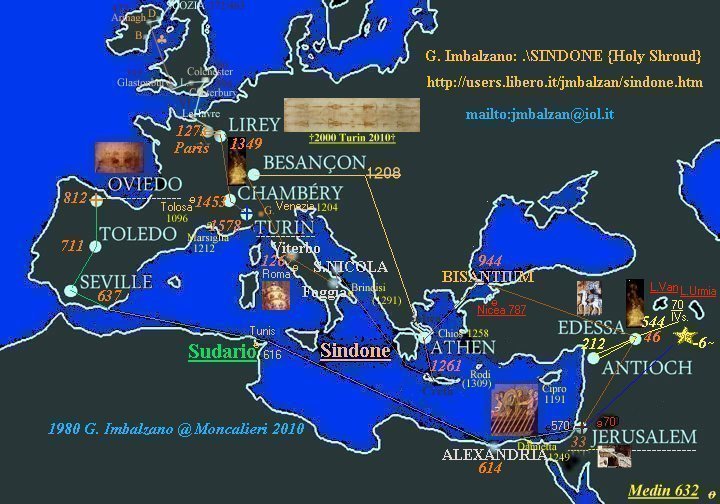
![]() The Holy See is the barycentre of the triangle {Jerusalem - Oviedo - Turin}.
The Holy See is the barycentre of the triangle {Jerusalem - Oviedo - Turin}.
On the basis of the correlation with the Shroud of Oviedo and the documents on the path of the Shroud of Jerusalem, the Man is died before the 46 AD.
But we can infer something more precise if we find where the date of his burial was transcribed, as in the tradition. When you have seen all that well, you will see that, not by pure logic or alone by faith! Have Hope of find, and the pure consciousness of what you seek, and you shall find. For the science is important the Hope of the discovery, but the most important, do not forget this, is Charity: If we are not prepared for this, not we have found anything!
Exodus, 70 AC: the Bishop of Jerusalem Simeon, cousin of the Lord, it shelters to Petra over the Jordanian,
hiding the Sudarium there where this will be seen by the "Pilgrim of Piacenza" in 570.
![]() Jerusalem
44
AC:
James the Major is executed and Peter is imprisoned by Herod Agrippa: but
Peter escapes by a miracle and Agrippa dies electrocuted.
Peter continues his mission with Paul in Antioch (46)
entrusting the Bishopric of Jerusalem to James, a cousin of Lord, hiding the
Christ Shroud and other objects in a small Ark, while his brother
Thaddeus will be sent Edessa
with the Shroud. In 62 James is stoned; while Paul is a prisoner in Rome,
perhaps in 64 Peter skulk in Babylon.
Jerusalem
44
AC:
James the Major is executed and Peter is imprisoned by Herod Agrippa: but
Peter escapes by a miracle and Agrippa dies electrocuted.
Peter continues his mission with Paul in Antioch (46)
entrusting the Bishopric of Jerusalem to James, a cousin of Lord, hiding the
Christ Shroud and other objects in a small Ark, while his brother
Thaddeus will be sent Edessa
with the Shroud. In 62 James is stoned; while Paul is a prisoner in Rome,
perhaps in 64 Peter skulk in Babylon.
But soon he abandon Syria to Thomas, who hit the road for the India, and Cappadocia to Jude Thaddeus, the Apostle more near Jerusalem.
Soon, Peter conquer Babylon of Nero with his own martyrdom in 67, and is the Christianity.
Tiberius Julius ![]() Caesar XIXanno
Caesar XIXanno
The Man of the Shroud died in the 33 AC and the probable age was on 38 year; also the discordance with an historical approximation of the II century (Gv 2,20) is a warranty of the authenticity of the date. Furthermore, under the mark (XIX) I characterized one (XX^) correspondent to the use of Syrian dating of Antioch, the native land of Luca (doctor and painter). Furthermore, under the mark (XIX) I characterized one (XX^) correspondent to the use of Syrian dating of Antioch, the native land of Luca (doctor and painter).
In effetti, come nel 325 disse S. Nouné ricordando il georgiano Niaforis, Luca ebbe fra le mani il Sacro Telo poco dopo S. Pietro. Essi avrebbero mostrato la Sindone alla
moglie di Pilato, Claudia, in Gerusalemme solo fino al 36 dC (secondo la Chiesa greco-ortodossa, Claudia si convertì al Cristianesimo).
Beside the date, I have found also the initial characters of "Christus Nazarenus Messias Iesus Pastor Emanuel".
All this is coherent with the Gospel of S. Matthew (the tax-collector of the Roman) and with the
(Tiberius)ת (Julius)ג (Caesar)כ XIXa:
in the details the writing appear Jewish, the Roman date corresponds to the 33 AC. The same date is repeated elsewhere, in particular as (XX') on the basis of the Syrian dating, a method usual by St. Lukas: he had in hand the shroud with St. Peter as Niaforis of Georgia said to Nouné (325).
![]()
![]() The same date is
doubled on the Shroud, exactly to the height of the Sudarium, and also near a
corner of the Sudarium of Oviedo
The same date is
doubled on the Shroud, exactly to the height of the Sudarium, and also near a
corner of the Sudarium of Oviedo
![]()
![]()
In the Sudarium of Oviedo, I founded the same date TJCXIX: even if here the written one is very tenuous, this involves a mutual authentication with the Shroud!
The dating-C14 of the Sudarium (Max 700 BC) confirm the "double" contamination of the Shroud (Max 1400 BC) due to its transport in volcanic areas, as well as the birth of the linen just there, while the Sudarium were screened better than the Holy Shroud, exactly when the Chineses have sighted three (super?) novae, besides that of the 5 BC, in unusually near times: 386, 393 e 436. Interpreting the more ancient Apocryphal (200 BC), linens they were entrusted to the grandsons of Mary, the siblings James (Sudarium of Jerusalem) and Thaddaeus (Shroud of Edessa). Despite the step (Gv 2,20) the tradition of the Church considers 33 (not the 30) the year of the crucifixion, perhaps because in that year there was an eclipse of Moon, the 3 Friday April, between the hours 14 and 15 (before the Roman's ninth hour): "some went out and with lamps, they thinking that it was the night, some of them felling" (Apocryphal Gospel of Peter V,18, 125 BC). The forenoon of 19 Thursdays March, in effect a eclipse of Sun there has been, and this made certain fright to the Hebrew, afraid that the Crucifixed mans may die after the festive lights, because this is severely forbidden from Torah books. The described phenomenon did not happen for nothing in the 30, but sure in 33 BC. Remember that the Moon-Earth-Sun conjunction emphasizes the tide, also fluvial and atmospheric, with certain movements of land (or pseudo-earthquakes). Finally, to Egyptians, Roman and Hebrew a sudden Shadow has to remembered the dark forces of the life and the dead women, analogously to the Fire.
I still cite Julius African (160-240) an impartial writer:
he mentions correctly the existence of a lunar eclipse and not of Sun
in the day of the death of Christ;
two weeks before, it was preceded by the eclipse of Sun, for the opposition of the two stars in comparison with the Earth.
Beyond gnostic complications, he affirms that the Advent of Jesus, that is that of its Word,
it was certainly the 16° year of Tiberius; adding the three Easter of the Gospels,
we obtain own the XIX year of Tiberius (33 DC)
like year of the Death and Resurrection of the Lord!
Anche il cronista greco Flegonte ci ricorda che nello stesso anno
(33 dC) prima dell'estate
della 203^ Olimpiade la Terra (almeno a Nicea, in Bitinia) divenne misteriosamente tenebrosa,
concordemente con quanto sopra. Quest'ultima descrizione potrebbe ricondursi alla presenza di ceneri vulcaniche,
che oscuravano periodicamente il Mar Egeo, fino all'Egitto.
Purtroppo, lo storico Tallo riporta malamente l'oscuramento come se fosse un'eclisse di Sole
localizzata su Gerusalemme,
e (solo) per questo particolare Giulio Africano lo critica duramente.
![]()
NOTE Some images hidden in the Shroud were
produced on purpose (by bigotry or vandalism) or occasionally by some improper
uses. In order
to determine those really meaningful (and in via preliminary) is necessary the confront of the positive photo with the negative, possibly searching a tridimensional figure.
1980 gi ![]()
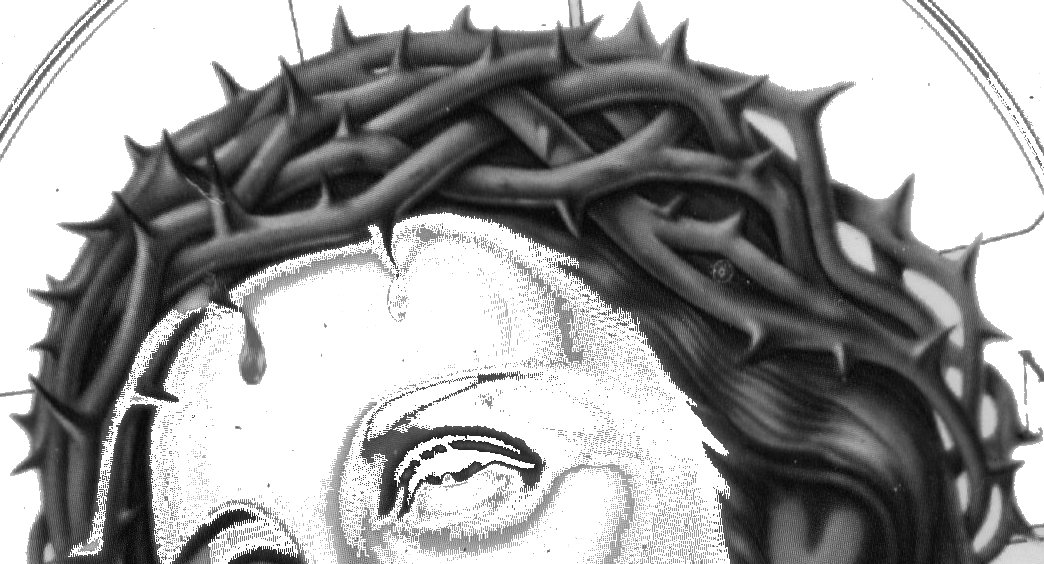 Crown of thorns helmet-like: spoors on the mysterious intermediate part
of the Shroud
Crown of thorns helmet-like: spoors on the mysterious intermediate part
of the Shroud

![]() gi 2010
gi 2010
The crown does not appear on the frontal part, but we remember as in that
time was prescribed to throw, on the head of the dead man, a heap of
land that, with myrrh and aloe, that it contributed certain to maintain stiff
the Shroud (where the mould is present diffusely, together with the pollens).
The radial dimensions of the crown are compatible with the Crown of "Nôtre Dame", imported from Jerusalem (in 409 was on Monte Sion, according to St. Paolino from Nola).
The crown was well
observed in 1500, as I describe in Leonardo & Company
![]() ‡ † ‡
‡ † ‡ ![]()
The spoor of blood to the wrist and to the foot, noticed also at the rear of the Shroud, are compatible with the section (1x1 cm
2) of the nail of "St. Cross in Jerusalem" of Rome; the length of this last is about 11.5 cm, same measure of nails to wrists of Jehohanan, a crucified of the 70 AC, founded in Givat Hamivtarin (Israel, 1970).‡ † ‡
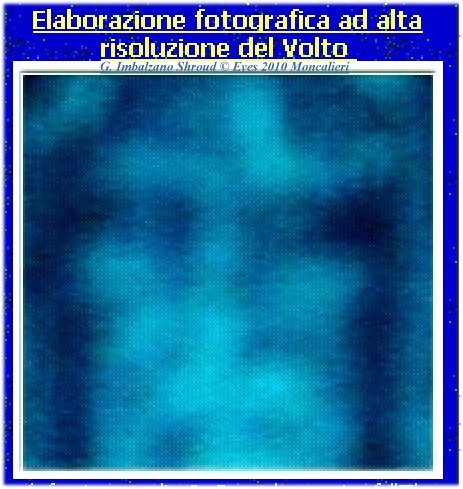 ‡ † ‡
‡ † ‡
{Appendix & Complement of "The magic history of the Holy Shroud" OR "La magica storia della Santa Sindone}
L'immagine è stata ottenuta, senza particolari artifici, selezionando le frequenze piu' opportune alla sua
visibilità. Alla massima risoluzione, essa è ben visibile solo sui toni di verde sul negativo fotografico;
sul positivo, questi toni corrispondono al predominio delle sfumature di fucsia, magenta e giallo che, come accertato sperimentalmente, si scuriscono nell'immagine del corpo.
Colori simili, tenui ed amorfi, prima del XIX secolo erano sconosciuti a pittori e tintori.
Né potevano sapere che l'immagine, finora evanescente, potesse rivelarsi (solo) per mezzo del computer.
La direzione dello sguardo sembra cambiare a seconda della disposizione fisica e psicologica dell'osservatore!
Già R. Voltolini ("Una foto diversa" II Convegno 1981 Bologna) mostrò una foto dove appare la pupilla sinistra diretta verso il basso, e quello destro confuso con un corpo tondeggiante al centro della palpebra.
Egli imputava il risultato ad una particolare angolazione delle sue riprese fotografiche; il confronto con la presente elaborazione riconduce la spiegazione del fenomeno alla rifrazione della luce,
ovvero alla cattura di lunghezze d'onda ben determinate. A tutto ciò G. Di Monaco (Traumatologia e Tanatologia oculare, III Congresso 1985 Trani) obbietta che le pupille dovrebbero apparire chiare su fondo scuro,
ma dobbiamo appunto considerare che al negativo questo fenomeno si inverte, come nelle foto mostrate. Egli aggiunge che i bulbi oculari di un morto normalmente dovrebbero rivolgersi verso l'alto, e tuttavia in
questo caso le pupille si fissarono al momento della morte, in modo conseguente ai profondi traumi vascolari (L. Coppini - P Baima Bollone, Rilievi anatomici per... lesioni da corona di spine, II Convegno 1981 Bologna).
Lo stesso Di Monaco ricorda: "L'ultimo sguardo di Gesu' fu per sua madre, poi gli occhi si chiusero e il colloquio continuò solo con l'Eterno Padre".

"Le immagini si mostrano all'uomo, ma la luce che è dentro di esse è celata nell'immagine della Luce del Padre" (Evangelo di Tommaso, 90)
Oggi che siamo in grado di verificare questi "movimenti" con un'osservazione accurata delle elaborazioni pancromatiche ad alta risoluzione,
dobbiamo ammettere che l'immagine del Volto si è formata in piu' fasi e con diverse lunghezze d'onda,
contrariamente alle altre ipotesi. Rimane da scegliere se tutto ciò fu dovuto ad inconsapevoli e improbabili ritocchi del reperto, o risolversi per quel che la scienza ritiene ancora piu' eccezionale:
l'esistenza documentata della Morte e Resurrezione di Gesu' Cristo. Come suaccennato, la riproduzione olografica mostra contrasti netti nelle parti di sangue e sulle ciglia,
mentre gli altri contorni sono sempre molto sfumati, riproducendo pertanto gli effetti tridimensionali, a partire da un'immagine di per sé piatta, ovvero "ortogonale".
Nella presente foto, le parti piu' luminose rappresentano le frequenze d'onda assorbite (dal corpo) che hanno prodotto sull'immagine del positivo l'iscurimento dei toni
complementari al blu, come il giallo ocra. Le frequenze luminose coinvolte, ben separabili, sembrano "ortocromatiche" come per un'onda LASER, ma rimangono pur sempre nel campo del visibile.
Tranne alcuni effetti secondari per la formazione dell'immagine, resta valida la teoria termografica elaborata dal sottoscritto fin dal 1980.
Questa teoria è intermedia fra quella vaporografica e dell'irraggiamento; ma a volte viene confusa con l'una o con l'altra teoria e non ben compresa.
Annotai al riguardo l'abbondanza sulla Sindone di Ferro ematico, e la innegabile azione del citocromo del sangue; questo ha una funzione analoga alla Clorofilla,
che assorbe determinati quanti di luce e in parte ne restituisce l'energia con una diversa lunghezza d'onda. Ricordiamo che essa viene oggi usata per sensibilizzare la colorazione di resine,
gelatine e film specialmente nel campo del Rosso, e inoltre accelera l'ossigenazione autotrofa, fermentazione che utilizza direttamente l'energia luminosa, senza l'uso di altre sostanze organiche.
Un'azione analoga sviluppa il lievito del pane, in cui possiamo osservare facilmente l'ossido-riduzione dei pigmenti (F. R. Jevons, The biochemical approach to life, 1961/1970 G. Allen & Unwin / Mondadori)
del tutto simile a quanto già dimostrato per l'immagine della Santa Sindone.
Nell'elaborazione fotografica, è evidente l'addensamento di sangue a livello della congiuntiva delle palpebre e delle gengive labiali; in concomitanza,
possiamo perciò delineare la coroide degli occhi (molto vascolarizzata) e perfino il contorno dei denti.
Naturalmente, una funzione analoga a quella dell'emocromo ebbe la soluzione medicamentosa di aloe e mirra sulla pelle dell'Uomo, per cui appaiono sulla Sindone le tipiche sfumature del corpo,
congiunte ad un innegabile effetto vaporigrafico. E tuttavia, non compare alcun alone di vapor acqueo dovuto alla normale respirazione polmonare:
basta osservare, quale contro esempio, l'alone lasciato dall'acqua usata per l'incendio del 1932.
Infine, aldisopra delle palpebre si notano piccole cicatrici ancora aperte,
verosimilmente procurate dall'accertamento oculare delle morte per mezzo di una punta di lancia, e ricordiamo che Pilato chiese a un centurione l'accertamento della morte (Mc 15,45)
anche dopo la ferita al torace procurata da un soldato romano (Gv 19,34).
Le ferite sulle palpebre non presentano sgocciolamenti di sangue verso il basso, come sarebbe per un corpo vivo, anche se fosse stato in coma profondo. Ne evinciamo che l'Uomo era veramente morto.
Egli semplicemente scomparve, lasciando solo la traccia di alcune funzioni enzimatiche di ossido-riduzione reversibili microscopicamente (respirazione molecolare).
1980/2010 Giovanni Imbalzano Lulu © The magic history of the Holy Shroud
From the first of centuries!
Apostles 33 AC Tomb
+° MILLENIUM: Thomas, Lucas, John, Joseph, Mary, Maguses..!
Magus's King ~ 6 BC Linen